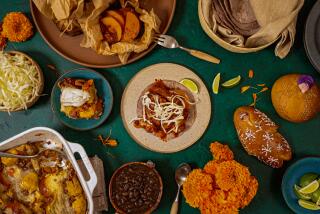FOOD : Home-Grown Cassoulet : Rancho Sisquoc Guests Feast on Home-Grown Produce and Meat
STEPHAN BEDFORD, THE wine maker at Rancho Sisquoc, has gained a reputation as one of the best cooks in the Santa Ynez Valley. Unlike most of us, Bedford does not schedule a trip to the supermarket when he plans a dinner. Instead, he draws upon a rich variety of fresh, ranch-raised produce and meat and his own wines.
Sisquoc is a Chumash Indian word for quail, which inhabit the territory along with squab, wild boar, bear and deer. Located between Solvang and Santa Maria, Rancho Sisquoc covers about 90,000 acres. More than a third of this vast spread is owned by the James Flood family of San Francisco; the rest of the acreage is leased. Cattle graze the pastures, seed beans are a major crop, and a small vineyard yields the grapes for wines that are sold only at the ranch. If what Bedford needs is not at hand, he obtains it from neighboring ranchers or from friends with flourishing vegetable and herb gardens.
The local bounty appeared full force in a cassoulet that Bedford prepared for a dinner at the winery during a regional wine festival. The ingredients included locally raised lamb, wild boar meat, four types of ranch-grown beans, and sausages made from wild boar, beef and venison. This zesty dish was seasoned with an abundance of fresh herbs contributed by Bedford’s friends and red wine that the young wine maker tipped into the huge pot when liquid was needed. For appetizers, there were crudites--vegetables obtained from nearby plots--with a spicy yogurt dip. Guests then sat down to a first course of steamed mussels accompanied by sweet peppers that had been roasted over a fire of ranch-grown oak. Walnuts from trees on the property added crunchiness to a salad of watercress, sorrel, endive and sun-dried tomatoes. Bedford himself made the long loaves of French bread that accompanied a cheese course, using Montrachet wine yeast for leavening.
The dessert was a pear-almond tart brushed with an apricot-orange glaze made with oranges plucked from a tree near Bedford’s home. Dinner guests sipped a syrupy, rich 1986 special select late harvest Johannisberg Riesling with the dessert. That ended a parade of wines that included a 1986 Franken Riesling and 1986 Johannisberg Riesling with the crudites; a 1986 Sauvignon Blanc with the mussels and peppers, and a 1985 Merlot with the cassoulet. Bedford even had a hand in the after-dinner drink, which was coffee brewed from Kenya coffee beans that he had roasted himself. The following recipe adapts his cassoulet to meats and sausages that are available in retail markets.
CASSOULET RANCHO SISQUOC 1 tablespoon black peppercorns 1/2 teaspoon cumin seeds 1/2 teaspoon dried red chiles1 teaspoon dry mustard1 tablespoon salt2 to 3 pounds leg or loin of lamb, boned2 to 3 pounds pork loin shoulder, boned
5 garlic or kielbasa sausages, about 1 pound cup rendered ham or bacon fatGarlicCooked Dried Beans2 tablespoons fresh parsley leaves1 tablespoon fresh sage leaves1 tablespoon fresh rosemary leaves1 tablespoon fresh thyme leavesAdditional stock or red wine In a mortar, crush peppercorns, cumin seeds and chiles together (use portion of chiles employed in bean preparation). Add mustard and salt. Slice lamb into long thick pieces. Cut pork into large chunks. Rub meat with crushed seasoning mixture. Pierce sausage casings. Heat fat in large pan. Quickly brown lamb, pork and sausage. Remove and set aside. Rub a large cast-iron or pottery casserole with garlic. Cover bottom with layer of beans. Top with slices of lamb. Add a layer of beans. Top with of the stock reserved from cooking beans. Add more beans and top with chunks of pork. Add another layer of beans and top with thickly sliced sausage. Top with remaining beans. Add enough reserved stock to come to top of beans. Sprinkle with parsley, sage, rosemary and thyme. Bake at 375 degrees 1 1/2 to 2 hours. During baking, a crisp crust will form. Every half hour, break up crust with wooden spoon and stir back into beans to melt. If beans seem dry, add additional stock or red wine. Makes 10 to 12 servings.
Cooked Dried Beans 1 cup small dry white beans1 cup small dry red beans1 cup small dry brown beansWater1 pig’s foot1 lamb shank cup rendered ham or bacon fat5 small dried red chiles1 onion5 cloves garlic1 large carrot, sliced1 teaspoon black pepper1 teaspoon tarragon1 teaspoon sage1 teaspoon thyme1 teaspoon bay leaves1 teaspoon rosemary Wash beans and combine in large pot. Cover with cold water, allowing about 3 cups to each cup beans. Bring slowly to a boil. Remove from heat and let stand, covered, 1 hour. Heat rendered fat in large skillet. Add chiles and fry about 1 minute. Do not allow them to break. Remove and set aside, saving some to season lamb and pork. In same pan, brown pig’s foot and lamb shank. Add to beans with whole onion, garlic, carrot, pepper, tarragon, sage, thyme, bay leaves and rosemary. Bring to a slow boil. Cover, reduce heat and cook until tender, about 1 1/2 hours. Adjust seasoning if necessary. Drain beans and reserve stock. Add water to measure 3 1/2 cups. Remove pig’s foot and lamb shank, cut up meat and return to beans.
Photographed by Jeff Sarpa / Food styled by Ana Adal.
More to Read
Eat your way across L.A.
Get our weekly Tasting Notes newsletter for reviews, news and more.
You may occasionally receive promotional content from the Los Angeles Times.







